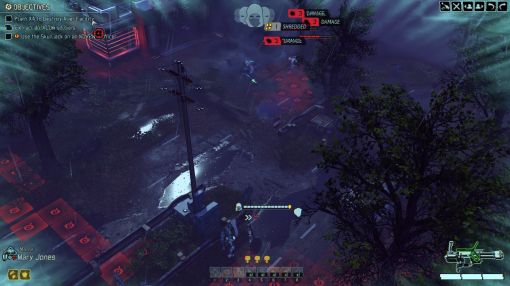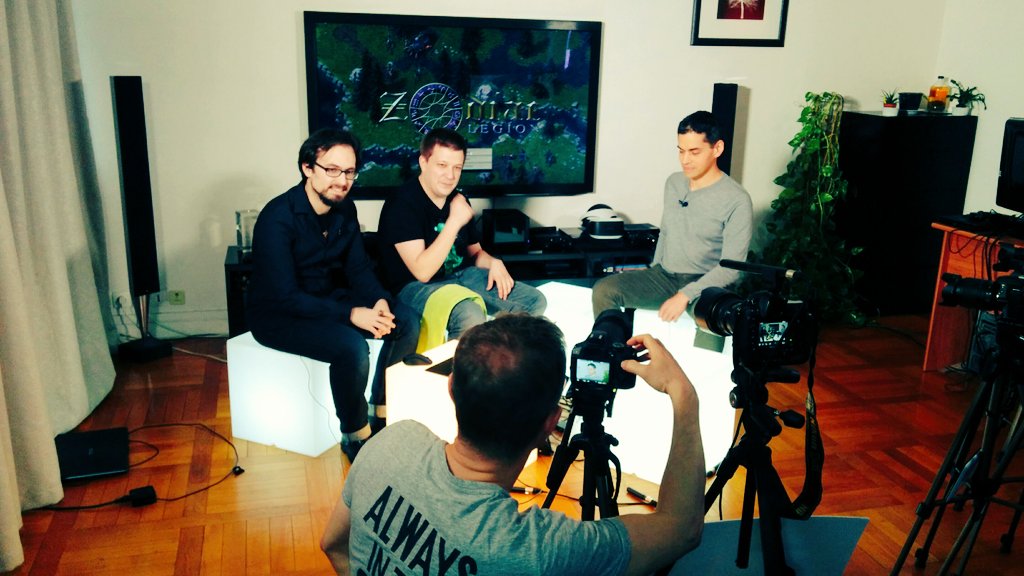Thanks for the questions,
PanteraNera
I will try to give some more concrete examples to some of them.
How exactly has X-Com and Jagged Alliance been inspired you and what similarities are there?
Is base building in and how does it work?
X-COM mostly inspired the "meta" element of the game: the focus on research and base building. I also want the game to be close to its spirit by letting you throw endless warriors into the meatgrinder to solve problems.
Territory control will work a bit like in JA2: once you get a region (by first weakening its opposition through some raid missions, then assaulting its castle), it produces resources for you, but it can be retaken. There will be some allied forces that will play the same role as Jagged Alliance militias (aka, serve as speedbumps), or provide you with an endless supply of redshirts in some missions.
You will also mostly be able to do some assault missions proactively.
Your main base will be the only one with magic reasearch and enchantment capabilities.
Think of the other ones as outposts (or interceptor bases), that provide a teleportation relay, and let you see mission opportunities around.
Both the main bases and the outpost can be fortified, but as much as I would have loved that, you won't be able to choose the wall layout. You will only be able to choose the type of fortification (like in Lords of the Realms 2 and not a detailed castle plan like in LOTR1).
How will tactical battles play? (explanation how many actions a hero can do in one turn, initiative?)
There is no initiative in the game: One side moves entirely, then the opposing side does the same.
Each character can move and perform a single action per turn.
As in XCOM, there are two movement ranges. The standard one allows you to perform most actions, and the extended movement range cost stamina, limits the actions you can perform, and gives you an ATT and DEF malus for the turn. It also removes your zond of control.
Some actions (like shooting with a bow) get a penalty as soon as you move. Other require you not to move at all. Some spells require you to concentrate one turn before being able to cast them.
There is no facing, but characters have a zone of control: It costs more movement points to leave a ZOC, and give the leaving character a malus.
Being in the ZoC of 3 opposing characters that are not in any of your allies's ZOC gives you an ATT and DEF malus.
A character is flanked when there are no tiles that are not in an opponen ZoC around him. Being flanked gives an ATT bonus to the opponents.
What stats/attributes will the heroes/enemies have?
We decided to use a limited number of stats, and offload most of the bonuses to perks and skills:
Stats are:
- Health
- Stamina/Mana
- Move
- Attack
- Defense
- Damage
Weapons and armors also have similar stats: (max stamina/health modifier), and have the following stats (some characters/creatures may have natural pierce and armor).
- Pierce
- Armor
- encumbrance
How many hero classes will be in the game?
The game will feature the main 4 DnD archetypes: Warrior, Support, Rogue, and Mage
Each can then be specialized into one of the 13 zodiac classes.
Do heroes have skills and how do they work?
There are no skills in the PnP RPG sense. Skills work more like feats/character class abilities.
Passive skills can do things like add flanking damage (or limit it), give passive stamina regeneration, encumbrance reduction, or improve some of the base actions.
Active skills cover special attacks (some will only work with certain weapons), spells, and utility.
How are damage and armor going to work?
During an attack, the attack and defense rolls are compared. If attack < defense, it is a miss. If they are equal, it is a grazing hit. If att>defense, it is a solid hit, and if att>defense+2, it is a critical hit.
a grazing hit removes 2 damage from the attack, a solid hit deals normal damage, and a critical hit does additional effect depending on the weapon (bleed, stun, or just extra damage for example).
Armor is substracted from the damage, but unless the attack is a grazing hit, or the damage is below -1, the character will take at least 1 point of damage when hit.
Encumbrance is deducted from max stamina, and can also limit your movement range.
How is magic going to work? Does every of the thirteen different zodiacs go accordingly to the four elements and how do they differ? What is the 13ht zodiac?
Spells cost an action and mana to cast. Some will only trigger on the next turn (the delayed fireball has a larger AoE and damage than the regular one, but only lands one turn later).
There was a plan to tie each zodiac sign to its astrological element, but it might be too limiting, so we'll see about that.
The 13th sign is
Ophiuchus.
How will leveling be handled? (skills, perks, traits, increasing stats)
Every level will provide a perk or trait. Some level will also let a character improve a stat. There will be some randomness on level up (like in Blood Bowl: you always have access to your regular skills, but you can also pick other skills instead depending on a random level up roll).
Stats will stay in the 1-10 range.
How is mana working? How is it connected to stamina?
When you cast a spell, you use mana if you have some. When you don't, the cost is substraced from your maximum stamina.
You can replenish stamina by using the rest action, but you cannot recover mana or go beyond your modified maximum stamina this way.
Some mana fountains let you replenish both mana and max stamina.
How many weapon classes will be in the game and how many in total? What stats do they have? Can you enhance weapons? Are there unique/legendary weapons? How many weapons has the game in total?
The weapons currently in game are:
axe/greataxe (versatile weapon against both unarmored and armored targets).
sword/greatsword (mediocre penetration, but good attack and defense values)
hammer/polehammer (good armor penetration, can stun targets)
bec de corbin (very good armor penetration)
halberd (reach, and supporting bonus to nearby friends).
flail (havles shield bonus)
cudgel (low tech/improvised weapon)
bow
scepter (grants casting benefits)
Shield (buckler, round, knight, kite, and tower shield).
As I said in the stats/Attributes, they have the following stats:
ATT/DEF modifier (def can be specific to melee, ranged or magic too).
Damage
Pierce
2 Hander usually have better attack, damage. They also have a good melee defense, while one hander+shield give better generic defense.
encumbrance (most weapons don't have any, but the heavier shields do).
they also have critical effects, and can be enchanted (to provide on demand elemental attacks).
Unique/Legendary weapons will be split in several parts that will need to be reforged.
How will the strategic layer work? (diplomacy, events)
This part is still evolving a lot. It will basically play a bit like Star Wars Rebellion (or Twilight Struggle):
You assign non combat characters and resources on missions (diplomacy, espionnage, ...), and the resolution of these missions will usually trigger a tactical battle whose difficulty and outcome will depend on the relative efforts deployed by both sides on the contested area.
Events will either trigger missions, alter some ongoing non combat missions, and usually present you with either a moral choice, or a choice between several options.
We try our best to make sure all options are reasonable under some circumstances (so that you can really choose to take option A because you need more manpower now over option B which would have given you more resources, at the cost of some of your soldiers and workers for instance).
How is research going to work?
It won't be overly original. You find scrolls or tomes, that can either reveal other mission locations, or help you advance your knowledge of magic/enchantment/alchemy.
Magic gives you more options for skill up.
Alchemy allows to to brew potions and explosives.
Enchantment allows you to improve your weapons.
One use items are still free to use (the in universe reason for that is that potions have a very short lifetime, so what limits them is your access to alchemical resources and your number of alchemists).
How far is game development? May there be big/drastic changes like features getting cut or completely changed?
There is no functionning geoscape to really show, but a tactical module that works relatively well. So the strategic part can still change a lot, but the tactical part will mostly get added content and balance.
How many different mission types will the game have and how do they differ?
This can still change, but the following missions are planned:
- Assassination
- item retrieval(artifact, scroll...)
- Take and hold
- Sabotage (ie destroy something and get out)
- escort
- Assault/Defense
- (Dis)Activate objective
Most missions have a soft timer (increasing enemy reinforcements over time).
Some will have a hard one (Hold objective for X turns, or kill opponent before he can get out).
Some will also give you friendly cannon fodder.
Retrieving an artifact obviously requires the character who took it to get to an exit.
How many different enemy types will be in the game? Are there bosses?
There will be 3 types of opponents:
- Humanoids (which will have character classes similar to the player), guardians (skeletons, golems, gargoyles), and demons (minotaurs/satyres, winged beasts, shades, fireball scorpion).
Humanoids threatens your borders, or defend them from your operations.
Guardians keep watch over old ruins and other places to loot.
Demons raid your own territory.
All of the enemy also have access to every weapons and most armor, so two sekeleton warriors can differ if one is in heavy armor with a two hander, and the second an archer without any protection.
Opponents also have color-coded elites.
Bosses would play like the lieutenants of Descent: They will give a bonus to their warriors for all battles happening around them, and can sometimes physically be present during missions.
But we don't have unique non humanoid characters yet (and all humanoid characters are paperdolled).






































